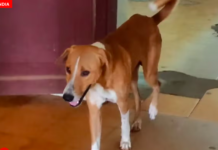Last Updated on August 13, 2023 by Fumipets
Causes of Dog Dandruff and How to Get Rid of It
Dogs, our beloved companions, can experience dandruff, a condition that may leave them uncomfortable and us concerned. Much like humans, dogs can develop dandruff due to various factors. From environmental influences to underlying health issues, understanding the causes and effective remedies is essential for their well-being.
This article delves into the possible culprits behind dog dandruff and offers practical solutions to alleviate this common concern. By identifying the root causes and implementing proper care, you can help your furry friend regain their comfort and confidence, ensuring a healthier coat and a happier companion.
Causes of Dog Dandruff
Your dog has been leaving flakes on his favorite dog bed and has dry, white flakes on his back, you observe. It is nothing to worry about if this peeling is just sporadic and he seems to be in good health otherwise, but continuous flaking and/or itching may be a sign that something else is wrong.
Can Dogs Get Dandruff As Humans Do?
Yes! Similar to in people, dandruff develops in dogs when flakes of dead skin cells begin to cling to the hair and other areas where they settle. In contrast to people, dogs often develop dandruff on their backs, particularly in the area closest to the tail.
Your dog may have dry white “flakes” on his coat or in his favorite hangout spots. Additionally, if you give him a good scratch, you may observe that his skin is flaky and dry.
Dandruff is medically referred to as seborrheic dermatitis. Sebaceous glands on your dog’s skin create sebum, an oil that keeps the skin supple and moisturized.
A skin imbalance results from these glands overproducing sebum. Seborrhea sicca (dry seborrhea) and seborrhea oleosa (oily seborrhea) are the two types of seborrheic dermatitis. Dogs may possess a mix of the two.
What Causes Dandruff on Dogs?
Dogs of any breed or mix might get dandruff for a number of reasons. In certain situations, it is a fundamental problem brought on by a genetic disorder like primary seborrhea, which affects afflicted breeds like cocker spaniels, West Highland white terriers, and basset hounds most often, or ichthyosis, which affects breeds like golden retrievers, Cavalier King Charles spaniels, and Yorkshire terriers. However, it is more often brought on by an underlying medical condition or something in the surroundings.

Dry Air
Similar to humans, dogs might have dry skin during the winter when the air is drier than usual. Forced air heating may make the problem worse. Lack of humidity in the air may be to fault if you only see dandruff on your dog during the winter.
Walking Dandruff and Other Parasites
Cheyletiella mites resemble white dandruff flakes and are big enough to be seen with the unaided eye. These unwanted visitors, which dwell and feed on your dog’s skin like fleas, ticks, and Demodex and Sarcoptes mites, will make him very itchy.
Obesity and Nutritional Issues
Your dog may be deficient in nutrients that are necessary for the health of his skin and hair due to an inappropriate diet. Ensure that the food you are feeding your dog is of the highest quality and is balanced.
Some dogs benefit from supplementary dietary supplements of fatty acids like omega-3s and omega-6s because they have a function in skin health. But before adding anything new to your dog’s food, it’s crucial to see your veterinarian.
As you are aware, obesity increases your dog’s risk for a broad range of illnesses. Poor skin health is just the beginning.
Skin Infections
Additionally, bacterial and fungal skin diseases may result in dandruff. These little invaders could also leverage the skin’s vulnerability as a result of your dog’s other health issues to spread an infection.
Bacterial and fungal infections need to be treated properly to restore your dog’s skin to a healthy condition, regardless of whether dandruff or the skin infection appeared first.
Allergies
Dogs with food and environmental sensitivities often have skin issues. Affected dogs may have persistent ear and skin infections, have seasonal itching, or have a propensity to lick their paws. Dandruff is often only one sign of allergies in dogs.
Hormonal Conditions
Changes in the health of your dog’s skin might be brought on by conditions like hypothyroidism and Cushing’s disease. He will also be more susceptible to secondary infections due to a compromised immune system.
Idiopathic Seborrhea
The term “idiopathic” or “spontaneous” is used when we don’t know the exact etiology of seborrheic dermatitis in certain cases. When a dog’s flaky skin has an unknown etiology, it may be relieved symptomatically, and further maintenance care can be given as required.

When to See the Vet for Your Dog’s Dandruff Problem
It’s usually nothing to worry about if your dog just sometimes or seasonally exhibits slight dandruff. But if your dog also exhibits any of these signs, you should make an appointment with your veterinarian right away:
- Itchiness
- An odor to the skin
- Excessive amounts of dandruff
- Hair loss
- Red, irritated skin
- Other signs of illness or discomfort
The specific symptoms your dog exhibits and what your veterinarian believes could be the issue based on a physical examination will be used to determine the source of your dog’s dandruff.
A skin scrape to screen for parasites, a culture to check for bacterial and fungal infections, and/or blood testing to check for underlying systemic illnesses may be performed by your veterinarian.
Dog Dandruff Treatment and Home Remedies
Your dog’s dandruff may be treatable on your own at home, depending on how bad the condition is. Include a few of these suggestions in your usual care to assist your dog’s dandruff to get under control and feel more at ease once again.
Grooming
Dogs’ skin and coat health are mostly dependent on regular grooming, which is also crucial for controlling dandruff. By brushing your dog, you may remove dead hair and help spread out extra skin oils so they don’t collect on the skin. When your dog has a dandruff outbreak, brush it every day.
For regular maintenance grooming, brush once a week. For long-haired dogs, misting with water or using a conditioning spray made specifically for canines might help reduce static. However, you should first speak with your veterinarian to ensure that any grooming products you use won’t affect any treatments your dog is undergoing.
Bathing
Bathing your dog may help with bacterial and fungal diseases as well as seborrhea breakouts. Your veterinarian could recommend an appropriate medicated shampoo after she has determined what is causing your dog’s skin issues.
Pay close attention to the bottle’s instructions. Some shampoos need to sit on the dog for a while before they start to work. Pay attention to your dog’s bathing schedule as well, since frequent washing may dry up your dog’s skin and exacerbate already existing symptoms or lead to new ones.
After every bath, be sure to completely rinse since many shampoos may be unpleasant if they are not rinsed out, whether you are using a medicated shampoo to treat a dandruff outbreak or ordinary shampoo to maintain hygiene.
Supplements
Additionally, your veterinarian could advise supplementing your dog’s diet with omega-3 and omega-6 fatty acids. Always use caution while selecting supplements since they are less strictly controlled than pharmaceuticals. If your veterinarian suggests a product, look for one that has the National Animal Supplement Council Quality Seal.
Healthy Diet
Feeding your dog a balanced food that satisfies his or her nutritional requirements is important. Select a diet that either has an AAFCO Statement on the label stating that it has undergone feeding trials or that it satisfies the nutritional profiles for the life stage of your dog.
Humidifier Usage
Using a humidifier in your home or apartment during the winter or if you live in a dry region may be advantageous (for you and your pets!). Your dog will feel more at ease and less itchy thanks to the steam’s ability to calm and nourish his dry skin.
Treat Other Health Conditions
Your dog will need to be treated for any underlying issues he may have in addition to at-home care to control his dandruff.
This may include treatment for bacterial infections with antibiotics, fungal infections with antifungals, immune-mediated illnesses with steroids and/or immunosuppressants, and allergic reactions with testing and therapy. Your dog’s skin will be considerably better after the underlying problem is treated.
Frequently Asked Questions
What are the common causes of dandruff in dogs?
Dog dandruff can be caused by various factors, including dry skin, allergies, poor nutrition, fungal or bacterial infections, and underlying health issues.
How can I tell if my dog has dandruff?
Look for white, flaky skin particles on your dog’s coat and bedding. If you notice excessive scratching, itching, or a dull coat, it might indicate dandruff.
How can I address dandruff caused by dry skin?
Regular grooming and the use of moisturizing shampoos can help alleviate dandruff caused by dry skin. Omega-3 fatty acid supplements in their diet can also promote skin health.
Can allergies contribute to dog dandruff?
Yes, allergies can trigger dandruff in dogs. Addressing underlying allergies through proper veterinary care and allergy management can help reduce dandruff symptoms.
Are there home remedies to treat mild dandruff in dogs?
Yes, you can try adding coconut oil to their diet, brushing their coat regularly to remove flakes, and ensuring they stay hydrated. However, consulting a veterinarian is recommended for proper diagnosis and treatment.
https://www.youtube.com/watch?v=gQyJtEqRbnM


















